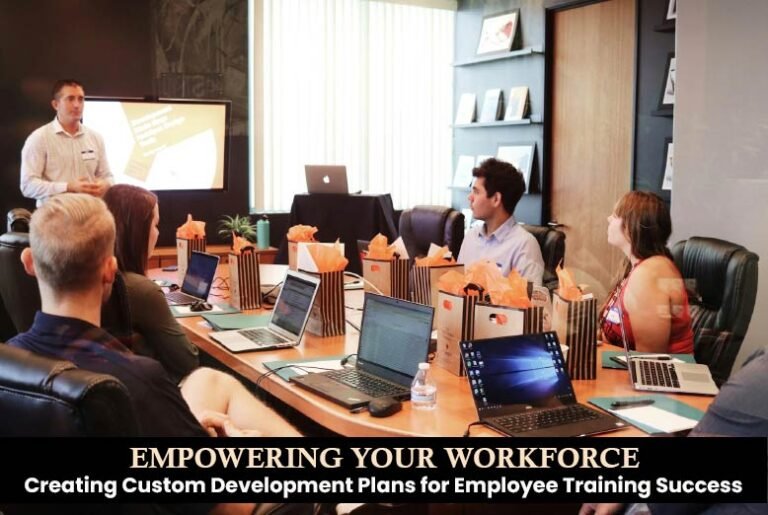In the fast-evolving business environment we have today, giving employees the tools and knowledge they need to operate at the highest level possible is not only vital for maintaining your competitiveness but ultimately required for ensuring your long-term success.
It’s a well-known fact that investing in learning and development pays off; at present, 57% of companies spend money on their staff’s professional training. One of the most effective ways to achieve this is through personalized development plans that take into account each person’s individual strengths, weakest points, and aspirations. The following article dives deeper into how companies can ensure employee training success.
Identifying Individual Needs and Setting Clear Objectives
The initial step in developing tailor-made development plans for employees is identifying their specific needs and setting clear objectives. This may require conducting extensive assessments of their current skills, competencies, and areas for development. This way you can create tailored training programs designed specifically to address each employee’s requirements and help them realize their full potential.
Once you’ve identified individual needs, the next step should be setting clear and achievable objectives for every employee’s development plan. These should align both with career aspirations and goals as well as with organizational strategic initiatives, providing employees with a concrete map for their development journey and helping to monitor their progression effectively.
Providing Diverse Learning Opportunities
An integral element of effective development plans is providing employees with diverse learning opportunities tailored to each employee’s personal learning styles and preferences. This comprehensive approach integrates formal training programs, on-the-job learning experiences, mentorship opportunities, and access to resources like online courses and workshops.
Formal training programs provide structured learning experiences to develop employees’ essential skills and knowledge relevant to their roles. On-the-job learning experiences offer direct training that allows employees to apply theoretical knowledge in practical settings, thus helping to facilitate practical skill acquisition and foster practical expertise development.
Mentorship opportunities connect employees with experienced mentors who offer advice, assistance, and insights that accelerate both their personal learning journeys as well as professional advancement.
By investing in one of the best online training software and providing employees access, you’re allowing them to learn continuously every day, and even have access to learning materials at their disposal, providing opportunities to explore unfamiliar subjects, acquire specific skills, and stay current with industry developments at their own pace. This not only enhances their professional growth but also contributes to a more skilled and adaptable workforce, ultimately benefiting the organization as a whole.
Regular Feedback and Assessment
Continuous feedback and assessment are integral parts of effective development plans, with managers playing an essential role by checking in regularly with employees to discuss progress, provide constructive criticism on performance, and adapt development plans as necessary.
Through regular dialogue between managers and employees regarding progress or challenges, organizations can foster an environment in which learning and growth take priority resulting in enhanced employee development as well as overall organizational success.

Fostering a Culture of Continuous Learning
Custom development plans not only focus on individual growth, but they can also foster an environment of continuous learning within an organization. Encouraging employees to take responsibility for their development and explore opportunities for growth while sharing knowledge and skills among colleagues is vital in creating an agile, adaptable workforce ready to face new challenges.
This proactive approach to learning not only benefits individual employees but contributes significantly to overall organizational success and innovation.
Creating Clear Progress Metrics
Implementation of effective development plans also depends upon setting clear progress metrics and providing employees with tangible benchmarks to strive towards.
Setting clear metrics for skill development, performance improvement, and career advancement allows employees to track their own development against organizational goals as they track and meet each metric. In doing so they can track progress, identify areas for development, and stay motivated toward reaching targets while keeping managers up-to-date.
Furthermore, this transparent approach also enables managers to provide targeted support and guidance resulting in more successful development outcomes.
Bottom Line
In conclusion, custom development plans play a vital role in empowering your workforce and driving employee training success. By identifying individual needs, setting clear objectives, providing diverse learning opportunities, offering regular feedback and assessment, and fostering a culture of continuous learning, you can create a workforce that is motivated, engaged, and equipped with the skills needed to thrive in today’s dynamic business environment. Investing in employee development is not just an investment in your workforce but also in the future success of your organization.
Also Read: Reasons Why You Should Invest In Technology Training For Your Employees



